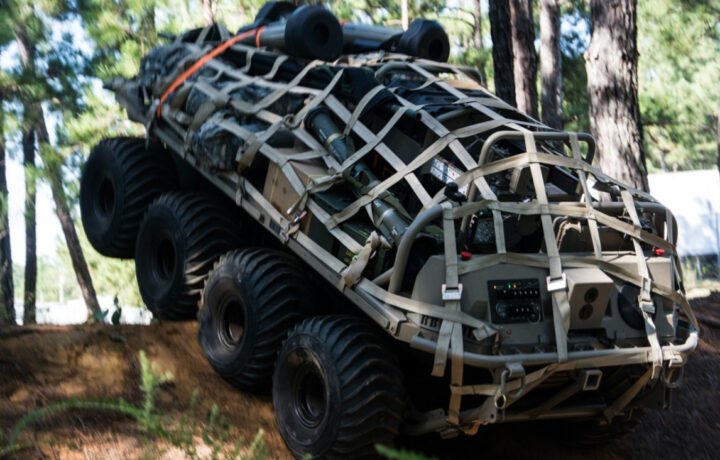Many of the United States military’s land-based vehicles are largely unchanged from the Cold War-era. The U.S. Army is still relying on an upgraded M1 Abrams main battle tank (MBT), which first entered service more than 40 years ago. However, last month, a hybrid Abrams was unveiled, while the Army has been looking at how other vehicles could also go green.
Other changes could be coming as well. Just as the United States Air Force and Army have been testing aircraft that can operate without a pilot, some support vehicles may not need a driver.
Earlier this month, General Dynamics Land Systems, announced that it delivered an initial tranche of 16 Small Multipurpose Equipment Transport (S-MET) vehicles. These are the first ground robots of their kind in U.S. Army history.
Based upon the General Dynamic Multi-Utility Tactical Transport (MUTT), the S-MET is an eight-wheeled that utilizes robotic technology to aid the dismounted soldier. GD won the Army’s competition for the S-MET program in 2020.
“We are proud to deliver this breakthrough unmanned ground vehicle capability,” said Gordon Stein, vice president and general manager of U.S. operations at General Dynamics Land Systems. “Through our partnership with the Army, General Dynamics Land Systems has remained at the leading edge of robotic combat vehicles that are designed to relieve soldiers of dull, dirty, and dangerous missions now and into the future.”
Robotic Mule
The defense contractor said the vehicles can serve as an equipment-carrying “robotic mule,” while it also has built-in flexibility for a wide variety of combat, combat support, and combat service support functions and payloads. It is equipped with a hybrid-electric powertrain, and can provide expeditionary power generation.
Though the vehicle is not actually autonomous, however – it can be operated by a single-hand remote control. It will still ease the moving of material, especially over rugged terrain.
“Back when we had real cavalry, soldiers had horses and mules to carry their gear; when we moved to vehicles, we lost much of that utility because soldiers deploy out of the vehicles, which can become targets of opportunity for drones, rockets, and artillery,” said Rob Enderle of the Enderle Group.
“What was needed was a small mobile solution that could replace a horse or mule for portage, be small enough to avoid detection, and go where a soldier on foot goes without providing extra management overhead or detracting from the soldier’s mission,” Enderle told ClearanceJobs. “Autonomous wheeled, and dog/mule-like robots with legs, are being utilized with increasing success in these portage roles assuring soldiers are well equipped without having to carry excess weight.”
Self-Flying Helicopter
The S-MET is just the latest U.S. Army vehicle that could ease the workload for soldiers. Over three days, as part of the U.S. Army’s recent Project Convergence 2022 (PC22) exercise drills, a Sikorsky UH-60 Black Hawk medium-lift helicopter took part in a test flight without pilot at the Yuma Proving Ground, Arizona.
Sikorsky, which is now a subsidiary of Lockheed Martin, and the Defense Advanced Research Projects Agency (DARPA) successfully demonstrated to the Army how an unmanned Black Hawk helicopter flying autonomously could safely and reliably perform internal and external cargo resupply missions, and during a rescue operation.
According to DARPA, this could give Army commanders and aviators greater flexibility in how and when aircraft and pilots are used, especially in limited visibility or contested environments.
During the first demonstration, the Black Hawk aircraft successfully flew 83 miles while loaded with 400 units of real and simulated blood – totaling 500 pounds. On reaching 40 miles from its initial take-off point, the helicopter descended into a valley as low as 200 feet above ground level at 100 knots. In its follow-up combined mission demonstration, the helicopter lifted off with a 2,600-pound external load attached to a 40-foot sling and successfully flew at 100 knots for 30 minutes toward a designated landing zone.
Whether in the air or on the ground, support vehicles will increasingly utilize autonomous technology including artificial intelligence (AI) and machine learning to fill roles that previously required a human operator.
“Autonomous technology increases range, safety, and mobility – and the effectiveness of mobile weapons systems because they can also carry ammunition – significantly improving the chance of a successful mission outcome,” explained Enderle. “Solutions like the S-MET will be critical to assuring the safety, viability, and firepower of tomorrow’s military.”




